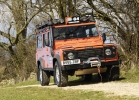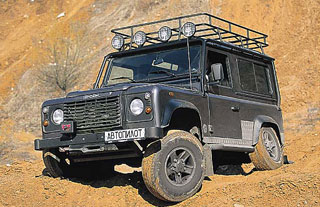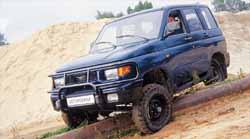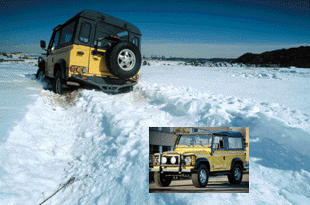Test drive Land Rover Defender 110 1991 - 2007 SUV
The last of the Mogican
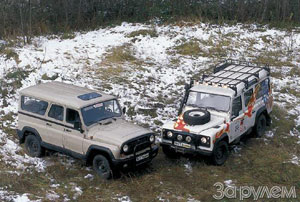 Land Rover Defender Land Rover Defender
Land Rover Defender Land Rover Defender The Land Rover Defender has been produced since 1983 in options 90, 110, 130, which approximately corresponds to the size of the wheelbase in inches (from 2360 to 3226 mm). The main body options are three-, five -door and pickup. The most common engine is a 2.5-liter turbodiesel, in small quantities modifications with a 3.9-liter gasoline engine are produced. The gearbox is only a mechanical five -speed.
UAZ 3153
The progenitor of the current UAZ, model 469 has been produced since 1972. UAZ 3153 appeared in 1996, its main differences: an elongated 380 mm base and a spring front suspension. The car is equipped with a 2.9-liter carburetor engine and a four-speed manual gearbox.
To the barrier!
There are few truly utilitarian all-terrain vehicles all over the world, and these last of the Mogikan are inferior to the place of more comfortable machines on the asphalt. Another thing is off -road. Here they still have no equal. By the way, only in this discipline the products of the domestic auto industry still seem to be competitive. To confirm or refute this, we compared the British Land Rover and his Russian analogue of UAZ, throwing it towards the legend and trusting only the facts.
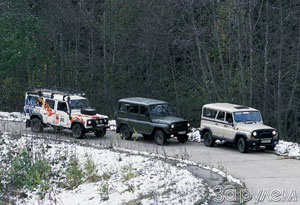 On the battlefield, the land-Rover defender 110 TDI costs $ 40 thousand and UAZ 3153, whose price is now difficult to determine: in solid currency for the year it has decreased from $ 10,000 to $ 4000. Their engines are different: a 2.5-liter diesel with a turbocharger near the defender and a 2.9-liter carburetor engine UMZ-4218.10 at UAZ. In general, not classmates at all, but there is no domestic diesel in the production program yet. The transmission of the Lend Rover also differs from the UAZ - here a permanent all -wheel drive is implemented with a blocked center differential.
On the battlefield, the land-Rover defender 110 TDI costs $ 40 thousand and UAZ 3153, whose price is now difficult to determine: in solid currency for the year it has decreased from $ 10,000 to $ 4000. Their engines are different: a 2.5-liter diesel with a turbocharger near the defender and a 2.9-liter carburetor engine UMZ-4218.10 at UAZ. In general, not classmates at all, but there is no domestic diesel in the production program yet. The transmission of the Lend Rover also differs from the UAZ - here a permanent all -wheel drive is implemented with a blocked center differential. He does not disappoint the first glance at the elongated UAZ, but upon closer examination, flaws typical for our auto industry come out. The low quality of the assembly and coloring, freely dangling switches - it is simply boring to list, as well as to look at the road through the cracks between the doors and the body. The defender against this background looks simply brilliant.
But if the driver still got into the UAZ salon through a narrow doorway, he will find that sitting in it is much more convenient than in a land-rover. In the defender, the driver is located below, his legs are more elongated, he is pressed with his shoulder to the door, and the pedal node and the steering wheel are strongly shifted to the left. The ergonomics of the defender is far from perfect, but the devices are well read, and the controls work clearly and do not require much effort. It is more difficult with UAZ: it is difficult to turn the car created by order of the Ministry of Defense into a civilian, even if you install a soft upholstery of the front panel and a semblance of a console.
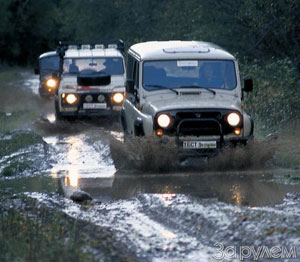 On the asphalt
On the asphalt Both cars are quite clumsy on the road, but the painful diesel of the Lend Rover allows you to easily win from the place, acceleration and any other sprint disciplines. But the maximum speed of the machines is almost the same, although the engine of the Englishman is noticeably more powerful. Most likely, the case is an impressive expeditionary trunk with a chandelier that do not improve aerodynamics.
In the turns, it should be careful for the driver of the land -rover - the car is greatly rolled and reacts to a sharp turn of the steering wheel with great delay. UAZ, thanks to a stiffer suspension, is more willing to respond to the driver's requirements, and highway tires
K-153 have good grip qualities on the asphalt.
As for the brakes, they are not particularly effective for both machines. The defender, whose equipped mass is almost 2 tons, with disk brakes requires 55 meters to stop at a speed of 100 km/h, and the UAZ with drums at such a speed is not enough and 60 meters: it is simply impossible to keep it in a straight line with intense braking. In addition, after a long drive along the wet road, its brakes almost completely lose their effectiveness.
On the ground
Autumn rains were the best suited for our plans. Cleaned, with shallow ruts, the clay primer turned into an ideal rink of light red color, only occasionally separated by deep promoons. Managing UAZ on such a coating is not easy due to an insensitive steering wheel, but a large energy intensity of the suspension allows you to overcome promoons, almost without reducing speed. The defender under these conditions is better obeyed by the driver, but it requires slow to slow down in front of large pits - his suspension is soft for races in rough terrain.
... you will be waist
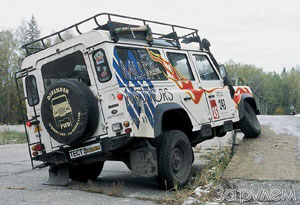 This, of course, is a clear exaggeration - hardly any driver, even on an all -wheel drive machine, will stick to a freshly faned clay field swollen from past rains. Mindful of the limited length of towing cables, we decided to storm the raised target first closer to the hard road. Both cars coped with the first exercise without much difficulty.
This, of course, is a clear exaggeration - hardly any driver, even on an all -wheel drive machine, will stick to a freshly faned clay field swollen from past rains. Mindful of the limited length of towing cables, we decided to storm the raised target first closer to the hard road. Both cars coped with the first exercise without much difficulty. The next passage away and deeper revealed a noticeable advantage of a land-rover: with a blocked interdose differential, he moved without a strong slip, periodically burrowing along the hub and a chirky bridge reducers along the ground. The English all -terrain vehicle was diligently crossed through the crests and furrows using impressive suspension passages. However, the tread tread, closed with mud, eloquently testified that the capabilities of the car were infinite.
UAZ was given the second swim with great difficulty: especially complex areas had to be overcome from the second attempt, piercing the track. Successful tires for asphalt turned into helpless bald rinks, with great difficulty moving the car forward. When trying to drive in the opposite direction, the car stuck. Only with great difficulty, having twisted back and forth, managed to get out on solid soil.
The third, most desperate attempt was made in a purely domestic one at random. Having deepened a dozen meters, this maybe, together with UAZ, they got stuck on the very ears. It took a towing cable to rescue the car. The evidence of the failed assault on the road was a complete imprint on the clay of the bottom of the car: the beams of bridges, the muffler and the cardan.
Someone will probably ask why it was necessary to climb into a deliberately impassable place in a car, which already barely overcame a less complex site?
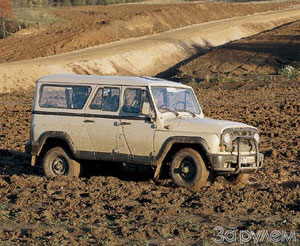 BECAUSE...
BECAUSE... Let us reveal the secret: the third car - the UAZ 31519, which, incidentally, performed the solo on a towing cable, took part in the test. Without going into the details, we explain: this is a standard short car with spring suspension, a hard top and a 2.9 liter engine. No, it was not equipped with a secret weapon like bridges with wheeled gearboxes or self -locking differentials. The main difference was in tires: on a short UAZ, II-357A tires were mounted in size 225/90R15. Looking ahead, we can safely recommend to those owners of UAZs who do not want to lose the cross -country ability of their cars, but are looking for acceptable comfort on the highway. Outwardly, they resemble well-known I-245 (these are not the most toothy tires of those that are put on UAZs), but, unlike them, have a radial frame.
And the short UAZ did not shame the honor of the brand. With a second gear in the main gearbox and lowered in the handout, he reserved a rut of a 40-centimeter depth! Drawing the stripes with gearboxes, supports of shock absorbers and both bridges, the car continued to move where it seemed impossible, including the site where his lanky relative stuck and where the Lend Rover did not dare. However, is it only a thing in tires and a short base?
Measurements revealed one curious fact. If the diagonal hanging of the defender wheels occurred when hitting an obstacle 650 mm high, UAZ 31519 climbed on a hill of 520 mm, then the stretch began to steer a wheel helplessly when the obstacle height was only 390 mm! Contrary to the widespread opinion that the spring suspension provides fet -to -rod moves than spring, everything turned out the other way around. The culprit is a thick anterior reptile stabilizer, clearly made to improve the behavior of the machine on the asphalt.
Incidentally, the absence of interval of inter -fire differentials to a certain extent is compensated by a long -flowing soft suspension, which allows the wheels not to lose contact with the soil.
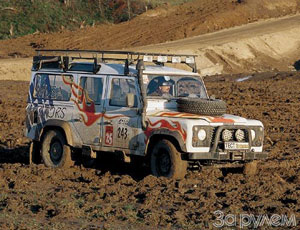 Instead of the conclusion
Instead of the conclusion In our comparison, it is difficult to be impartial, but, on the heart, we admit: in comparison with the predecessor, UAZ 3153 has lost a fair amount of cross -country ability to improve comfort, but did not reach the level of a defender, which, in general, is also not a standard. However, the British did not apply to the principles and did not sacrifice the off -road qualities of the car for driving along road roads. Among the unconditional advantages of the defender are the build quality, reliability, durability, powerful and economical diesel engine. Without going into the argument about the quality of the assembly of the UAZ, we give only a list of the largest troubles that occurred during the test: the pump spill was cut off, the pulley of the hydroelectric power storage pump fell apart, the nut on the valve pusher unscrewed, and when it was installed, it turned out that the gaps in the timing are missing completely. For the brake test, the pads had to be adjusted again. The Lend Rover, however, also could not do without malfunctions: the light bulb in the left headlight was burned ...
Is there one defender of seven UAZs? However, if you ask this question, you probably know the answer.
The editors thank the company Alan and Musa Motors, as well as the Ulyanovsk Automobile Plant for cars provided for test. Detailed sales information in the dealer price section.
UAZ 3153 Land Rover Defender 110
Uu body uuu
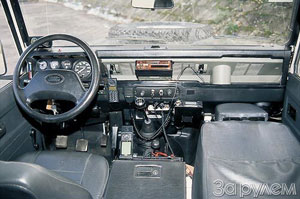 + Large volume of the salon + stainless aluminum body,
+ Large volume of the salon + stainless aluminum body, - Low quality manufacturing, lack of light -removable seats, maintainable
safety belts, poor quality riveted body design
coloring, uncomfortable access to the trunk, - a narrow opening of the rear door, uncomfortable
small doorways, non -permanent arrangement of glass windows
glass
Uuu driver's place uuu
+ Comfortable seat + light steering wheel, clear and light boots of the lever
- There is no gearbox in the standard configuration
steering wheel hydraulic, large moves - cramped (left) driver's place,
gearbox lever, governing organs shifted to the left,
the steering wheel is located, poor lateral vibrations on the controls
overview due to a high line
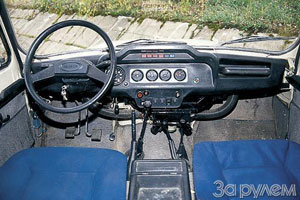 glazing, speedometer is located
glazing, speedometer is located in the invisible zone
Uuu movement uuu
+ The ability to turn off the front + a traction motor, a good dynamics
bridge, moderate body rolls - large body rolls
- Bad brakes
Uuu comfort uuu
+ Good stove, comfortable seats + soft suspension
- noisy transmission and engine, - uncomfortable seats, noise on high
drafts in the speed of speeds
Uuu off -road qualities uuu
+ Large road clearance + large suspensions, constant
- limited suspension passages, lack of all -wheel drive
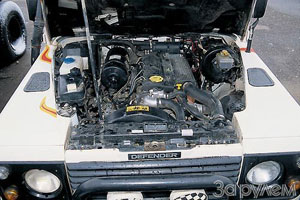 inter -long locks, protruding - the absence of inter -fire locks
inter -long locks, protruding - the absence of inter -fire locks down the muffler, unstable work
carburetor on large slopes
Uuu operation uuu
+ Low price, simplicity of service, + economical diesel engine
cheap low -octane gasoline - high price, expensive service,
- small mileage between TO (4000 km) difficult access to the motor compartment
TECHNICAL SPECIFICATIONS
car UAZ 3153 Factory Danas (in brackets UAZ 31519)
General data: number of places - 9 (7); Equipped mass - 1855 (1665) kg; Full mass - 2780 (2500) kg; maximum speed - 120 km/h; acceleration time from a place to 100 km/h - 34.7 s; fuel consumption at 90 km/h and Hz - 15.5; 14.5 l/100 km; fuel supply - 2x39 l; Fuel - A -76. Design: frame with steel body. Dimensions, mm: length - 4514 (4025); width - 1800; height - 2020; base - 2760 (2380); The track in front/back - 1445/1445; Road clearance - 220; The volume of the trunk is 1825/3166 (1131/2564) L; The turning radius is 7.3 (6.3) m. Engine: a four -cylinder in a row -in -line UMZ -4218.10, located in the front longitudinally; working volume - 2890 cm; cylinder diameter and piston stroke - 100.0x92.0 mm; compression degree - 6.7; Power - 63 kW/86 liters. With. at 4000 rpm; Maximum torque - 193 N.M at 2200-2500 rpm.
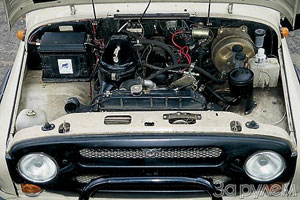 Transmission: all -wheel drive, front bridge - disconnected, there is no center differential, inter -normal differentials - free, front wheel couplings - with manual inclusion; gearbox - four -speed mechanical; Transporting numbers: I - 3.78 (4,12); II - 2.60 (2.64); III - 1.55 (1.58); IV - 1.00; h. X. - 4,12 (5,22); The main gear is 4.62; handout: I - 1.00; II - 1.94. Suspension: dependent; in front - two longitudinal levers, Panar's thrust, reptile stabilizer, springs (spring); Behind - spring. Brakes: drum with a vacuum amplifier. Steering: worm. Tire size: 225/75R16 (225/90R15).
Transmission: all -wheel drive, front bridge - disconnected, there is no center differential, inter -normal differentials - free, front wheel couplings - with manual inclusion; gearbox - four -speed mechanical; Transporting numbers: I - 3.78 (4,12); II - 2.60 (2.64); III - 1.55 (1.58); IV - 1.00; h. X. - 4,12 (5,22); The main gear is 4.62; handout: I - 1.00; II - 1.94. Suspension: dependent; in front - two longitudinal levers, Panar's thrust, reptile stabilizer, springs (spring); Behind - spring. Brakes: drum with a vacuum amplifier. Steering: worm. Tire size: 225/75R16 (225/90R15). Standard equipment
A full -size spare wheel in a case, a split folding seat of the second row, folding rear seats.
UAZ 3153
Fog lights, plastic overlays, kangaroos, hatch, hinged rear side.
Land Rover Defender 110
Roll hydraulic wire, heater/washer/rear window cleaner, baby-vol, audio training.
SUMMARY
Defender is an excellent all -terrain vehicle and, to some extent, a cult car. Due to the latter circumstances, the buyer will have to put up with a high price and some inconvenience. A long UAZ with a spring suspension on the asphalt is exactly as better than his short predecessor as it is worse on off -road. However, it suffers from a hereditary ailment - extremely low manufacturing. Maybe before cutting off the booties from the boots, trying to turn them into sneakers, it is better to first pour all the holes into them?
TECHNICAL SPECIFICATIONS
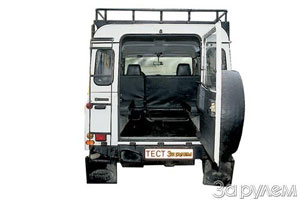 land Rover Defender car (factory Danae)
land Rover Defender car (factory Danae) General data: number of places - 9-10; Equipped mass - 1980 kg; full weight - 3050 kg; maximum speed - 134 km/h; acceleration time from a place to 100 km/h - 18.8 s; fuel consumption at 90, 120 km/h and Hz - 9.7; 14.6; 9.7 l/100 km; fuel supply - 80 liters; Fuel is diesel. Design: frame with aluminum body. Dimensions, mm: length - 4598; width - 1790; height - 1963 (without trunk); base - 2794; The track in front/back - 1485/1485; Road clearance - 190; The volume of the trunk - 1971/2690 l; The turning radius is 6.4 m. The engine: a four -cylinder diesel in the front is located longitudinally, with a turbocharged and intermediate cooler; working volume - 2494 cm; cylinder diameter and piston stroke - 90.5x97.0 mm; compression degree - 19.5; Power - 83 kW/113 liters. With. at 4000 rpm; The maximum torque is 265 N.M at 1800 rpm. Transmission: permanent all -wheel drive, an interdose differential - with forced locking, inter -measuring differentials - free, gearbox - mechanical five -speed, fully synchronized (including reverse transmission); Transporting numbers: I - 3.69; II - 2.13; III - 1.40; IV - 1.00; V - 0.77; h. X. - 3.43; The main gear is 3.54; handout: I - 1.41; II - 3.32. Suspension: dependent spring; in front - two longitudinal levers, traction of Panar; Behind - two longitudinal rod rods, a V -shaped central lever. Brakes: hydraulic disk with a vacuum amplifier, in front - ventilated. The steering: worm with a hydraulic wrap and a built -in shock absorber. Tire size: 245/75R16.
Anatoly Fomin, Yuri Nychetov. Photo by Vladimir Knyazev
Source: The magazine "Driving"





